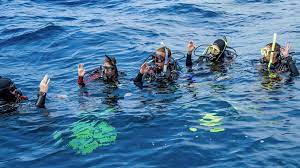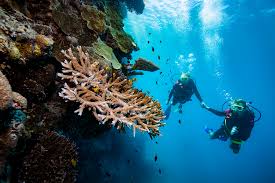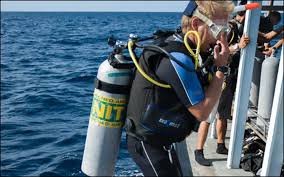

 Online Scuba Lessons |
 Online Nitrox Lessons |
Surface Tension
Scuba Diving Troubles
at the surface.



The surface is the barrier though with we must pass in order to be embraced by the sea. It's a tricky place. There is plenty of evidence to show that it is the most dangerous place for a scuba diver. Over the years I have observed some interesting phenomena that occur at the surface. I would like to share with you, but first I want you to do a self test.
Just imagine that moment when you have passed down through the surface and the liquid space closes overhead. The ocean has enveloped you and you are descending to the deep. Do you feel happy? Do you feel free? Do you feel that you have escaped the alien world of the surface? Do you feel excited but relaxed? These feelings of inter peace don't come easy, it takes practice and training to master the art of this type of recreation. Which means to Re - create!! Re-create one's self! If it's work to scuba dive, then you need more training and more experience.
One of the things that is obvious to me is that in order to experience this joy, understanding, and peace, you have to be self-sufficient. It is possible to share this with another self-sufficient diver, but it is NOT possible to experience this if your are dependent on another diver. You need to be able to recognize and understand all the real risks of diving that are relevant to the particular dive - and more importantly, know that you can improvise and overcome with your abilities and experience.

Training is vitally important; you need to master theory, diving skills, and navigation. When I say master, I mean, MASTER the skills. I've heard it said that the difference between beginners and experienced master divers is that beginners practice until they get it right. Masters practice until they can't get it wrong. To be truly at ease underwater you need to be a master at preparation and problem prevention at the surface as well.
Lets have a look at some strange things that happen on the surface. I like to call them "Surface Tensions", since they are all related to a basic confusion of the surface, with all its problems and stress, and the sea, with all of its joys and freedom. Surface Tensions reveal past or present psychological barriers to the full enjoyment of diving. What I find most revealing is the way divers handle the surface on their first dive. It is fascinating to see the problems they get themselves into. Those that are sensibly weighted, enter with no fuss, give the "big OK signal, and begin their descent, I know will be fine. Those that deliberately try to get to the surface before diving, I watch very carefully. If the mask is lifted to the top of the head, I immediately prepare for a rescue. (See Mask on, Mask off for a more detailed explanation of this strange and wonderful indicator of a divers experience and comfort level).
A more subtle indicator of a problem is when the diver raises his or her head while dumping the air from the BC. Instead of looking down into the water, the diver struggles with an unconscious desire to keep their head above the surface of the water. It is actually quite comical to see the obvious attempt to sink accompanied by the thrust up face and the frantic instinctive kicking of the fins - and then to put icing on the cake - their conclusion is that they need more weight!? An obvious ode to inexperience!! Finally the diver gets control of their emotions, freezes, and sinks, still staring at the the sky - still kicking their fins towards the surface, happy that they solved the problem by adding a bunch of lead to their belt - go figure!???
I also see divers unable to get the air out of their BC that they just pumped in there five seconds ago. Some of the time, it's a poorly designed BC that looks cool and the brochure promised that it would make them dive like dolphin or a whale or some other ego driven marketing ploy. But most of the time it's because the diver has forgotten how to vent the air from the BC - Inexperience!! Or the diver simply does not want to sink at that time. Surface tension strikes again.
Even with correct weights and all the air out of the BC, some divers are determined to battle with the surface to start the dive. Hint: the surface has more experience than you do!! This type of surface tension involves a massive breath in and thrashing fins - is it a giant tiger shark fighting a 20 foot hammerhead - No, just joe or jane beginner starting their dive! A true master would gently breath out and practice making a completely ripple-less submergence through the surface!!
Another example of irrational behavior on the surface is found with those that insist that a snorkel be worn, or carried, by scuba divers "for safety" or "to get back to the boat"! HA! In certain circumstances a snorkel may be useful - like when one goes "snorkeling" or a beach entry where a long surface swim is necessary to get to the dive site (but even then, I prefer to swim on my back, I can breath better through my month than I can through a 3/4 inch tube.) The last circumstance you want to fine yourself in is a long surface swim after the dive to get back to the boat. That kind of exercise promotes Decompression sickness (DCS). The whole point of boat diving is to get directly over the dive site (Duh....)
If you find yourself on the surface at the end of the dive away from the boat, it's because you have made a mistake in navigation! If this happens and the distance is to far to swim at, not on, the surface simply signal the boat that you want a pickup. Raise your hand over your head and hold it there - or even a hold a fin straight up. DO NOT wave it around - this means that there is an emergency and you need to be rescued immediately. When the rescuer gets to you and finds out that you simple made a mistake in your navigational skills - he or she is going to act like a rabid cat being stuffed into a 7-up bottle!! Just simply and calmly raise one hand to signal the boat for pickup. Once you have the boat's attention, you'll get the big OK signal (both hands raised overhead to make an O). Give the big ok signal back and then raise your hand calmly and slowly. You may need to alternate the ok signal and the pickup (or "come get me") signal.
The bad idea of snorkeling back to the boat after the dive also has some physics involved in it as well (you didn't think Bwana was going to write an article without a physics lesson did yah?). When you are trying to snorkel with a tank on your back, the weight of the tank will push you under water - you are trying to breathe with a negative lung pressure and will quickly become exhausted. If you try to put air in your vest, this will further compress your lungs. If there is any surface chop at all, the inertia of the tank and air in the BC will prevent you from bobbing with the waves and the snorkel will fill with water and you will drown. - Is it possible to scuba dive with a snorkel - Yes! But in most diving circumstances, it's DUMB!!
The surface is not the sea. Next time you
go for a scuba dive, check yourself to see how you handle the
surface. After all, the whole point of scuba diving is to
sink - and to JUST BE!
Sea you under the sea!
Bwana
![]()